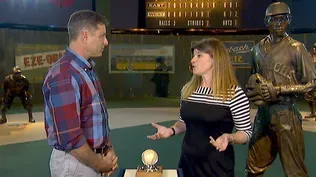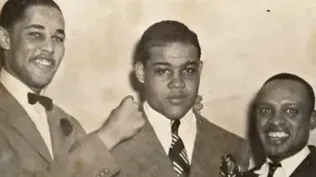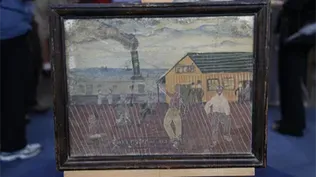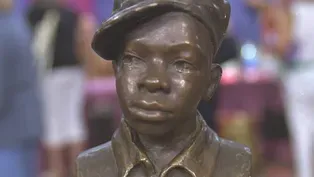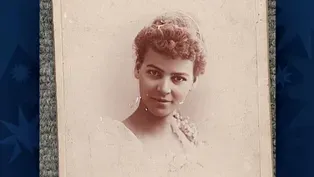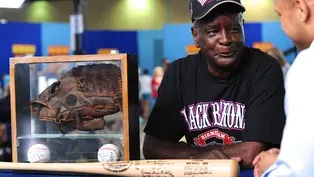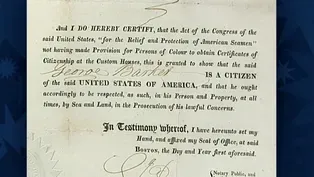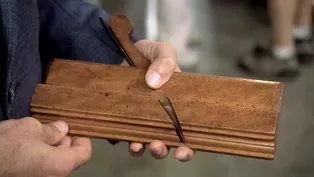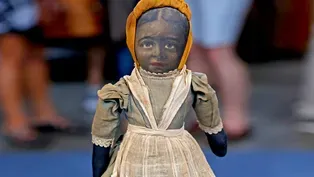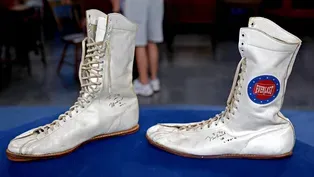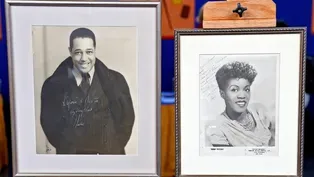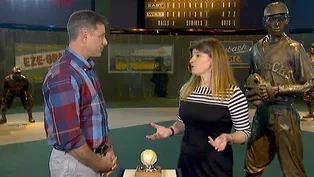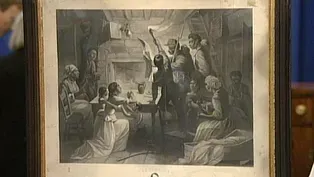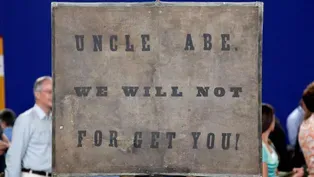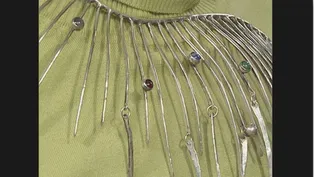
Special: Celebrating Black Americana
Season 19 Episode 34 | 53m 15sVideo has Closed Captions
ROADSHOW honors Black History Month in this special episode.
ANTIQUES ROADSHOW honors Black History Month with the special episode Celebrating Black Americana. Highlights include an 1821 U.S. citizenship certificate for George Barker, a free man of color; an African American beauty book written by Madam C.J. Walker, the first American female millionaire.
Funding for ANTIQUES ROADSHOW is provided by Ancestry and American Cruise Lines. Additional funding is provided by public television viewers.

Special: Celebrating Black Americana
Season 19 Episode 34 | 53m 15sVideo has Closed Captions
ANTIQUES ROADSHOW honors Black History Month with the special episode Celebrating Black Americana. Highlights include an 1821 U.S. citizenship certificate for George Barker, a free man of color; an African American beauty book written by Madam C.J. Walker, the first American female millionaire.
How to Watch Antiques Roadshow
Antiques Roadshow is available to stream on pbs.org and the free PBS App, available on iPhone, Apple TV, Android TV, Android smartphones, Amazon Fire TV, Amazon Fire Tablet, Roku, Samsung Smart TV, and Vizio.
Buy Now

ANTIQUES ROADSHOW 2025 Tour!
Enter now for a chance to win free tickets to ANTIQUES ROADSHOW's 2025 Tour! Plus, see which cities we're headed to!Providing Support for PBS.org
Learn Moreabout PBS online sponsorshipComing up in this hour, we are showcasing some incredible artifacts of African American history and culture.
So many times we hear people say that they hope they have a national treasure.
Well, your father really was a national treasure.
He was a jazz legend.
APPRAISER: Talk about goose bumps, when this walked in, I was speechless.
That's unbelievable!
And there's a lot more to explore in this special episode celebrating black Americana.
Stay tuned.
Welcome to Antiques Roadshow, celebrating black Americana.
Hi, I'm Mark Walberg.
From enslavement to emancipation, through segregation to the civil rights movement of the 20th century and on to the present day, the arts and objects of black Americana are tangible reminders of African Americans' struggles, achievements, creativity and innovation.
The prized objects you're about to see are related to black Americans who have impacted American culture and history in ways both large and small, starting with this impressive archive documenting one sailor's military service.
MAN: This material is about Charles Edward Minor, who was my great-grandfather.
He was born in Virginia and joined the Navy in Washington, D.C., in around 1887.
APPRAISER: What type of different ships did he serve on?
I think he started on the Dale, went to the Franklin, the New Hampshire, finished up on the Constellation, but was on the Buffalo, the Brooklyn, the Vermont, a number of ships.
Served in various wars, as far as the Spanish-American War, the Boxer Uprising or Boxer Rebellion, World War I.
He's been around the world approximately five times.
He was a busy sailor.
Absolutely.
Well, it really is a pretty amazing group.
As a sailor during the Spanish-American War and World War I, he really did have a lot of different ships that he served on.
What rank did he eventually reach in the service?
In 1907, he was appointed as a petty officer, but in 1917, he reached the rank of chief petty officer, which was pretty much unheard of.
There were four African American chief petty officers at that time.
His total service to this country was in and around 34 years.
We're very proud of that, and I think that there's some folks that should know in this country that African Americans served in a very meaningful capacity in the armed forces at that time.
Absolutely.
And here is a great cabinet card of your great-grandfather.
We see him in his sailor's uniform.
This would have been from the Spanish-American War period.
Mm-hmm.
And then here is his... basically the record of his enlistment, and the record of his service that he would have carried with him, which includes the different ships he served on, but it also includes his promotion to chief petty officer, right here, in 1917.
The enlistment is actually printed on vellum, or sheepskin.
Mm-hmm.
Even as a group that belonged to a white sailor, this would be quite rare because of all the service that the sailor saw.
But as an African American sailor, it's really amazing and rare, as you say.
And there's much interest in preserving the heritage from African American soldiers, sailors, et cetera.
Mm-hmm.
Conservatively, at auction, for the enlistment book with the record and the different ships he served on, including the two promotions, together with the original cabinet card from the Spanish-American War, we're talking $2,500 to $3,500.
Mm-hmm.
At auction.
And I'm just really glad you brought it in.
Incredibly rare.
Just very happy to share it with this country.
My father's family is originally from Newburyport, Massachusetts, and this document is my great-great-great-grandfather's.
He was a man of color living in Newburyport, Massachusetts, and this document allowed him to travel to the South, where he had relatives.
It's dated 1815.
And my father passed that down to us, so we treasure it.
And this we call the grandfather's chair.
Yes.
Now, we're not sure which grandfather.
We know it was my father's grandfather, but if it was his father... we don't know.
There are various dates under here: 1850-something, 17-something... We just always sat in it.
You can see the bottom is quite worn.
And you sat on this chair?
I sat on this chair, my father sat on this chair, probably his father as well.
You can see it's taken quite a beating.
It's a great heirloom.
This is a passport.
Okay.
It's a very straightforward document, and as we see, it's from Essex, town of Newburyport.
It's notarized by a man called Woart, W-O-A-R-T. And he is justice of the peace.
It's got his seal.
Yes.
And signature.
And, as you said, the date of 1815.
It's suffered a little bit of bloom and damage, a couple of holes here, but essentially, it's a great historical item.
We think so.
Here you have the respect given to a man of color in the North in 1815.
It's very early.
And the other interesting thing is, we have crossover here.
Yes.
And yes indeed, this is an absolutely genuine Massachusetts-made Windsor chair.
It is?
Oh, my goodness.
And as you've said, it's got some repair.
It's had its feet cut down, but it is a child's chair.
Yes.
At auction, the whole package is worth $2,000 to $3,000.
Okay, all right.
But obviously, it is of tremendous family significance.
Well, we treasure both items, and this chair has... A lot of bottoms have sat on it and we love it and hope to just keep passing it down.
Yes.
I acquired the document through the WGBH auction in 1978.
Oh, my goodness.
Yes.
And it was certainly before black memorabilia became... the rage, or popular that it is today, yes.
Yes, but because it was a certificate of citizenship for a person of color, I personally felt it should belong to a person of color, so I got the high bid.
How much did you pay for this in 1978?
I paid $75, which, at the time, my mother thought was outrageous.
It was well worth it.
This is an important document that is showing George Barker, the gentleman right here, and he was born in 1788, and that he is a free person of color and a citizen of America.
And it's showing descriptive information about his height-- he's 5'2"-- he has sable complexion and he has "woolly" hair.
(laughing): Yes.
Is that just not indicative of the time period, where they were describing African Americans "with woolly hair."
Exactly.
The other thing that's exciting is that down here, we have where it says, "for the relief and protection of American seamen, "not having made provision for persons of color to obtain certificates of citizenship."
Right.
This document is so important.
You have a wonderful seal right here, it's archivally framed, it's from Massachusetts.
I've never seen something like this.
Scholars, collectors, museums, libraries would eat this up.
How about $3,500 to $5,000 for this document?
Oh, my God, that's unbelievable.
Now, is your mom still living?
Yes, she is, and she's going to be mighty shocked.
Make sure you tell her that $75 many years ago was well spent.
WOMAN: This photo of Duke Ellington was given to my grandmother and my father when he was a teenager.
My grandfather used to be the doctor of Duke Ellington, and he passed away, and I guess he dedicated this photo to my father and my grandmother.
And my father ended up being a jazz musician years later.
So we're fortunate to have this.
You're going to have to elaborate.
So who's your father?
Oh, my father is Dexter Gordon.
So your father is the Dexter Gordon.
Famous tenor player and innovator of the bebop era, who has influenced John Coltrane and Sonny Rollins.
He's a fantastic jazz musician.
In the '80s, he made this movie called Round Midnight, which was based on a jazz musician living in Paris.
From that movie, he was nominated for an Academy Award in 1987.
And I think he actually...
Didn't he win the Grammy as well?
Yes, the album did win a Grammy.
And also, Herbie Hancock, who composed the music for the film, also won an Academy Award for music.
He has so many lives as a musician.
Yes.
And a professional career.
He played his entire life.
He had an exceptionally long career.
Yeah, in the '60s he did leave the States and lived in Copenhagen and in Paris.
In the '70s, he came back to the States and he made an album called Homecoming, which was recorded at the Village Vanguard, which brought him back to the States and created a whole new fan base for him.
And in the '80s, was offered this movie project from a famous French director named Bertrand Tavernier.
So many times, we hear people say that they hope they have a national treasure, but your father really was a national treasure, and he's a jazz legend that influenced so many musicians.
And like you said, he popularized the bebop on the tenor saxophone.
What we have in front of us, the Duke Ellington up there, which is Duke Ellington signing it to your grandmother and to your father.
And we have Sarah Vaughan, who wrote a really fun inscription to him.
Yes.
We have the Billie Holiday down there that's written to your father, and we also have this one that is your father on the left, with Joe Lewis and Lionel Hampton.
My father dedicated it to his mother, because he was in his 20s at that time.
So I have his signature, as well, his autograph.
So he signed this for his mother?
Yes, my grandmother.
And what I love about this photo is, one of his nicknames was Long Tall Dexter because he's 6'6".
So he makes Lionel Hampton look exceptionally small in this photo.
He was a little guy.
He was little, and it's even dramatized by the fact that your father's 6'6".
So in terms of value, if we were putting a value on these, just if they were signed to anybody, if it's Billie Holiday signing to someone that we don't know, it has one value.
But the fact that they're signed to your father and he is who he is takes it to a completely different level.
So if you were to insure these, you would definitely want to insure them for no less than $15,000.
Whoa.
My husband is an avid collector.
And he was able to get this from a collection in Durham, and it shows when he visited St. Mark's AME Zion Church in Durham.
And he was the president of the Southern Christian Leadership Conference, and this is from their conference when they were here in Raleigh in 1966.
And along with that, he was able to acquire the book from the same collection.
Well, that's what's so fantastic is that it comes from the period.
It's direct from 1966, when the visit occurred.
This was at the apex of Martin Luther King, Jr.'s ascendency in his importance as a cultural leader.
Yes.
And what I think is really terrific about the dust jacket on this book is its pristine condition.
With all modern literature, whether it's a historical book or a piece of fiction, collectors care about the preservation of the dust jacket.
And it's just immaculate.
What makes this even more special is the fact that it has been signed.
It's been signed on the front free endpaper.
And because it was signed at the time of these others, we are very confident that the signature is authentic.
Yes.
In terms of value, the book is going to be worth about $2,000 to $3,000, since it's signed.
Unsigned, they bring in the low hundreds.
As an archive, I would give it a premium value and therefore say that everything together is in the $3,000 to $4,000 range, and that's an auction value.
Wow, my husband is going to be really excited.
Oh, terrific.
WOMAN: My mother had a friend, Miss Foster, and Miss Foster was 90 and going into a nursing home, and Mother said, "She would like you to come over and pick out something from the apartment."
And I saw this young boy, and I said, "He's darling; may I have him?"
And Miss Foster said, "I'd love you to have him."
This is a sculpture by an artist named Augusta Savage.
And she was a black artist who worked in New York in the 1920s and '30s.
And this is her most famous work.
It's called Gamin.
And it's actually inscribed on the front, "Gamin."
Uh-huh.
And the piece is signed on the back with her name, "Savage."
And what's interesting about this piece is that while it looks like it's bronze, it's actually made out of plaster, and it's painted to look like bronze.
And if you look on the bottom here, you can see the white plaster.
She didn't have the money to cast them in bronze.
It was a very expensive process.
This is a wonderful piece.
It really captures the spirit of this young boy.
It does.
It comes in this size, and there's another version that's slightly larger.
Oh, did she make many of them?
No, not really, because there just wasn't a demand for them, and I think even if she made a lot of them, because they're plaster, they're very fragile.
In fact, yours knocked over and cracked.
Yes.
Well, I think you might be surprised.
This is worth between $15,000 and $20,000.
With a crack?
With a crack, yes.
Isn't that great?
That's wonderful.
I cannot believe that.
I...
It can even bring more.
WOMAN: I found this in a Georgetown antique store on the floor, kind of hidden in a stack of other paintings, and I just found it appealing.
I didn't know anything about it, and I just wanted it and bought it for not very much money.
It had to be far less than $200.
Maybe even $85.
And how long ago was that?
About 15 years, I think.
Well, it's a charming and remarkable piece.
And you talked a little bit about the title of it, Dancing for Eels.
Yes.
What do you know about that?
I had never heard of dancing for eels, but what I found out was that in the mid-19th century, at the Catharine Street Wharf, black people would-- men, I suppose-- would just dance for eels.
And I can't imagine.
I guess there are places where, you know, people eat eels.
I know that.
But it just seems so interesting.
And it was in the history books, but it took me a long time to actually find a reference to dancing for eels.
I, too, did a little bit of research, and what I discovered is that this particular composition goes back to a drawing that was made in 1820.
And what it was depicting was enslaved African Americans who went from New Jersey to the Catharine Street Wharf to sell produce.
And they joined free African Americans in New York and danced for eels.
Oh, my.
So, what's interesting to me from an historical context about this is here is something that was depicted in the 1820s...
Yes.
...and this picture dates to about 1880 or 1890.
Oh, my.
So it's a subject and a composition that has a long popularity in American culture.
Mm-hmm.
And what I particularly like about this one is that you've got the figure of a child on a stool, you've got musicians in the background-- one playing a banjo, you have the dancers, people standing in the background, you have a smokestack.
This painting appears to be done on canvas, laid over a tin backing, and the paint medium is oil paint, with the lines that you see scratched into the paint surface.
I think in today's market, at auction, we're talking about something that would sell in the range of $6,000 to $9,000.
Oh, my!
So your investment... (laughing): Oh, my goodness.
...really did well.
Oh, my.
(laughing): I'm shocked.
Yeah.
MAN: These were the shoes that Muhammad Ali wore in the very famous heavyweight championship fight The Thrilla in Manila.
It happened in 1975.
It was their third and final fight.
After the fight, he used these... Ali used these shoes to train in.
And I don't know how long he trained in them, but eventually the right front toe came loose.
And... there.
And Angelo Dundee, the trainer, took them because they weren't useful anymore.
Ali wanted to get... drop them.
So he sent them to me, and I had them autographed later.
Well, let's talk about the fight again a minute.
How did they come to determine the name Thrilla in Manila?
Ali was a bit of a poet, if you remember.
He was, "Float like a butterfly, sting like a bee," and The Rumble in the Jungle when he fought George Foreman.
So he came up with a little bit of poetry for this fight.
He always did it to promote the sale of tickets and all.
And I think I'm paraphrasing here, but he said, "This fight is going to be the killa, and a chilla, "and I'm going to beat the gorilla in the Thrilla in Manila."
And they ended up...
The press picked up that phrase and used Thrilla in Manila, and it's become one of the most historical heavyweight championship bouts ever.
When Frazier won the first match, Ali, with controversy, won the second fight.
Right.
And then Ali, of course, won the third and decisive fight with a TKO between the 14th and 15th round.
That's right.
Both of them took a brutal beating.
They both went to the hospital after that fight.
Now, you say you received these from Angelo Dundee.
And what other provenance do you have with these?
Any documentation?
No, I don't have documentation.
What happened is I was the executive sports editor of the Philadelphia Enquirer at that time, 1980, and I had asked Angelo for some promotional material for a promotion I was doing for the paper.
And he sent me a robe, an Ali robe, which I gave away as the winner of the promotion.
And he threw these shoes in with a note that says, "These are the shoes that he wore in Manila.
He discarded them because of the toe."
And he said, "I thought you might like to have them."
And that was in 1980.
The fight was 1975.
And of course, with something like this, the provenance is so important.
And in my research that I did, I have found another pair that was from the Thrilla in Manila, actually certified authentic as Ali's shoes that were worn in the Thrilla in Manila.
You're kidding.
I had no idea.
So what we have on this one, with what you heard from Angelo Dundee, is we have the provenance that these were known for sure to be training shoes worn by Ali.
Being an autographed pair of training shoes, we can put a value for these at auction for between $15,000 and $20,000.
Similar Ali boxing shoes that are from one of the big fights have sold for up to $100,000.
With the full provenance, the documented shoes from the Thrilla in Manila auctioned ten years ago, and at that time sold for $25,000.
Interesting.
But ten years ago.
Interesting.
Well, I've learned something today.
America's love of baseball goes back to the late 1800s, but until Jackie Robinson broke the color barrier in the major leagues in 1947, teams and fans were mostly segregated.
From 1920 to the early 1960s, teams of African American and Latino players participated in what is now called the Negro Leagues.
The Negro Leagues Baseball Museum in Kansas City has an amazing collection that showcases the legacy of black athletes' contributions to the sport before and after integration.
Leila, there are so many amazing things to see here at the museum, but this ball is absolutely a standout.
Tell me about this.
This ball dates from 1953.
We have four 1953 Dodgers on here.
We have Jackie Robinson, we have Roy Campanella, we have Joe Black and we have Junior Gilliam.
All of them had gotten their start in the Negro Leagues before they were signed by the Dodgers.
With the integration of Major League Baseball, it took a lot of the best Negro League players out of the mix and into the major leagues.
Consequently, they lost a lot of their following.
By the early '60s, the Negro Leagues were no more.
In 1953, the Dodgers played the Cubs at Wrigley Field.
John Moore, Jackie Robinson's friend, happened to be there that day and he had all four of them sign.
These gentlemen were all true pioneers.
You have Jackie Robinson, after he left the military in 1945, he actually signed with the Kansas City Monarchs, one of the greatest Negro League teams, and played with them for a season.
April 15, 1947, Jackie Robinson became the first black ballplayer to play for a major league team in the modern era and had a phenomenal career.
Then you've got Roy Campanella.
He came up with the Dodgers in 1948 and made an immediate impact.
He is considered today one of the greatest offensive and defensive catchers of all time.
Then you have Joe Black, not as well known but Rookie of the Year in 1952 for the Dodgers.
And then we have Junior Gilliam, who had a great career for the Dodgers and went on to coach for them until he passed away in 1978.
In 1953, the Dodgers had the most black players on their team.
They had the four players and five, if you included Don Newcombe, who was in military service at that time.
There were 16 major league teams in 1953.
Only eight of them were integrated.
It took until 1959 for the major leagues to be fully integrated, with Pumpsie Green going to the Red Sox.
WALBERG: Tell me about the other name on the ball.
DUNBAR: On the other side, we have Ty Cobb.
WALBERG: Which some people would say is very ironic because there are many who have said that he was somewhat of a bigot.
That's right, Mark.
I mean, Ty Cobb, one of the greatest players of all time from the Dead Ball era, his career is 1905 to 1928, and one of the most controversial as well.
To see him here at this ballgame is fascinating.
We know that John Moore went to Ty Cobb, who was sitting in the stands.
He had Cobb sign the ball.
We assume that after that, he went to the four Dodgers-- Robinson, Campanella, Black and Gilliam-- and had them all sign the ball.
I've never seen this combination of signatures before, and I'd place an insurance value of $15,000 on the ball.
The true value here is the history that it represents and symbolizes in being the transition from the Negro Leagues to the integrated major leagues.
Absolutely, and this is just one of the amazing things to see here at the museum, and thanks for sharing it with us.
Oh, happy to be here.
It's not very often that I get to interview a real celebrity.
Everybody knows who you are.
Alan Page, former football great, Supreme Court justice now, right, in Minnesota?
Yes.
And you bring in this fabulous piece.
Tell me about it.
Well, about 15 years ago, my wife and I were in the Chicago area visiting our daughter, and we wanted to look at memorabilia.
So she goes into the phone book and finds an ad or something, I can't remember precisely, for an antique dealer.
And we called them, they invited us over, and they had this piece.
I actually teared up when I saw it because it's such a... ...an emotional piece, at least for me.
We left without it.
My wife, unbeknownst to me, called back after we had left.
I was sort of depressed that we left without it.
And the following Christmas, this was my Christmas gift.
This is a parade banner that was used after Lincoln was assassinated.
Right.
"Uncle Abe, we will not forget you."
From the smallest town to the biggest city, there were demonstrations, parades, of mourning.
What I find interesting is the parade torch at the top.
Yes.
That this could have been used in a nighttime march.
And to see this with this great shaft... and I mean, I love the shaft.
The patina, the color...
The feel of it is...
It's got great feeling to it.
To see this in this condition is really amazing.
Let's take a look at the back side of it, because I think that that also is interesting.
This was a sentiment, of course, that was being expressed.
Our country, it's time to heal.
And when I saw that... you know, we haven't quite healed yet.
And when I say I got emotional, it was because this is the hope.
We still have that hope.
And really, after the assassination, just as draconian laws during the Jim Crow era that really didn't get wiped away until the 1960s, until the Civil Rights era.
Exactly.
And we're still struggling.
We're still struggling.
Now, in terms of political collectibles, the people who collect political items really like to have things that relate directly to the candidate being elected.
If this was, "Let's elect Abe," it would be in a whole different ballpark.
The Lincoln mourning items are a little bit... a step down in terms of value than the campaign items.
This, on the other hand, is such a special thing, with the original shaft, the torch, and the two-sided sign, that that really elevates the status of this piece.
If I were to put this in an auction of historical collectibles, I would think that this would be valued at somewhere between $15,000 and $25,000.
Oh, my goodness.
Well, it's not going to be put in the auction, but it's a pretty special piece.
We just love it.
Well, this is a collection of photographs and correspondence regarding family members from the turn of the century and the latter part of the 19th century, primarily revolving around James Wormley and the Wormley Hotel in Washington, D.C. And James Wormley was your great-great-grandfather.
He would have been my great-great-grandfather, that's correct.
He was an African American who owned what has been characterized as the preeminent hotel in Washington.
It was right at Lafayette Square.
And we have a picture of the hotel up here.
That's correct.
It's no longer standing, unfortunately, but that's a marvelous old shot of it.
Now, James Wormley also had another interesting distinction.
In 1865, he was a participant in a fairly historic event.
Can you tell us a little about that?
Yes, he was actually at the deathbed of Abraham Lincoln.
He was always called whenever there was a time of emergency or urgency.
And he actually was portrayed in Littlefield's picture of Lincoln's deathbed as the only African American in that image.
Well, one of the things I think is so interesting about this is the range of your family archive.
And you have photographs, wonderful tintypes.
Here's a little broadside on the death of James Wormley.
You have them in good albums here, where they're protected from handling and wear.
You've got them labeled wherever you can, because memories fade.
And if you know who someone is in a picture, get a label on it, as you've done.
Now, in terms of value, this is very unusual to see an African-American family archive of this extent.
And I think just for its unusual qualities and his historic figure, I would value this at about $5,000 at least, maybe more.
Well, thank you very much, I appreciate that.
Thanks for bringing it in.
What is someone from Wellesley doing with that necklace?
How did you get it?
What is it?
It's the first time I've ever worn it.
It's always been hanging on the wall.
It had been my mother's, but she never wore it either.
It didn't translate well from her excitement of New York to Andover, Massachusetts, where I grew up.
And where did she buy it?
She bought it I think from someone in Greenwich Village.
And that would have been what year, you think?
When I was in high school, probably in the early '60s.
Now, do you know who made it?
Yes, she told me someone named Art Smith made it.
And she bought it from the artist directly?
Right.
Well, I can tell you about Art Smith.
He was one of the art jewelers that worked in the '50s.
He started in 1953 and he had an upstairs studio in Greenwich Village.
There was a book called The Messengers of Modernism that talks about all these people that sort of were the beginning of the modern movement: Calder, Sam Kramer, Ed Wiener, and of course Art Smith.
Now, Art Smith was black, and he was one of the first black artists to do jewelry during that period.
He liked to do things that reminded him of tribal art, which as you can see, this certainly relates to that.
The necklace is in silver.
The stones are out of the quartz family.
They don't have great value and they're just very colorful, and some of them, when you move them, they turn.
The necklace is grand and certainly eye-catching.
In the market today, these necklaces are very, very collectible.
And I think what you've done by wearing it on a wall, so to speak, wearable art, is the perfect venue for something like this.
Any thoughts on it?
Do you love it?
Are you afraid of it?
Well, no, I'm not afraid of it.
I couldn't decide what to wear it with.
And I also noticed I couldn't find his name.
Could you find his name anywhere in it?
Now, this one is not signed.
Art Smith signed some pieces, didn't sign others.
I didn't think he'd have to sign this piece because to me, this is the ultimate piece of jewelry by Art Smith, and it continues all the way around.
As to value, are you curious?
Oh, well, of course, I'm curious.
I have no intention of doing anything beyond hanging it on the wall or maybe wearing it.
You are at a level today at $5,000 to $7,000 in the market.
Oh.
So you've got a valuable piece... Is that your final answer?
No, because you know what?
It could bring $10,000.
WOMAN: I don't really know a whole lot about the book.
I believe it's the first African-American beauty book.
APPRAISER: How did you acquire the book?
A friend of mine.
I'm a hairdresser, and he gave me the book.
He thought I might enjoy it.
The cover title says it's the textbook of Madam C.J.
Walker Schools of Beauty Culture.
Yes.
So at first blush, it just seems to be a textbook, and in the antiquarian book trade, we don't think a whole lot of most textbooks, but you really caught my attention when you said that this was an early hair products and hair care and styling book for African-American women.
Yes.
That definitely caught my interest.
Mine, too.
Did you learn anything from the book?
Actually, I did.
There are some home remedies I've tried out of the book, and then some of the product in the book you can no longer get.
Well, the book's around 100 years old, so... Oh, really?
Not surprising.
Yeah.
Let's open the book up here to the title page.
Okay.
Here we have The Madam C.J.
Walker Beauty Manual.
First edition.
And it indeed is the very first book published for hair styling and fashion for African-American women, which is very, very unusual.
There's one more page I'd like to turn to here in the back that shows some of the hair care products.
Quite a big, healthy line of different products.
Yes, it was very fascinating to me, looking at it and looking at the prices back then.
Pretty nostalgic.
Yes, yes.
You said that some of the methods and products involved in the book are still valid today?
Some are and some are not.
Okay.
You would know far more about that than I.
Yes, I am a licensed beautician.
What's interesting about this book is Madam Walker was actually Sarah Breedlove.
She was born on a Louisiana plantation in 1867.
Really?
Her family were a slave family on a plantation, and she was the first child in her family born into freedom after the Emancipation Proclamation.
I didn't know that.
And the company that bears her name is still in business to this day making hair and facial products for African-American women.
Really?
She also, according to the Guinness Book of World Records, is the first American self-made millionaire female.
Are you serious?
I didn't know that, either!
I had no clue.
Pretty fascinating.
Yeah.
Do you have an idea of what the book's worth?
Oh, I'm not for sure what it's worth.
Maybe $3,000.
The book's in very good condition.
It's not a fine condition copy, but in today's market, with the interest in early and important African-American material, the first edition of this book is scarce enough that at retail, this book would sell for $10,000 plus.
(laughing): $10,000?!
Are you serious?
I am serious.
Oh, you're kidding!
No, I'm not.
$10,000?!
Yes, ma'am.
(laughing) I don't believe it!
Thank you.
(laughing) BOY: My grandfather's a really big antique collector, and he gave me this.
It's a Cesar Chelor plane from 1725, and Cesar Chelor was the slave of Mr. Nicholson.
Francis Nicholson was the first known American plane maker, and Cesar Chelor worked for him as a slave, but Francis Nicholson freed him upon his death.
So 1753 is when Cesar Chelor became independent and started making planes with his own imprint.
He's the first African American to mark tools that he manufactured and one of the first African Americans to have an independent business in this country.
And if you read the stamp, it says "Cesar Chelor, living in Wrentham."
That's Wrentham, Massachusetts.
It's one of the top examples I've ever seen of his work.
It's wonderful condition, and the form, it cuts what's called a bolection molding, which is a complex molding.
Collectors love that because it's an architectural molding.
A Cesar Chelor plane is just the single most desirable molding plane you could ever possibly come by.
So I hope you appreciate what a wonderful gift your grandfather gave you.
Yeah.
The market is softer than it had been about five years ago, but I would say an auction estimate on this plane would be about $6,000 to $8,000, and it would have easily brought $12,000 about five or six years ago.
Do you think you'll be a tool collector one day?
Yeah, probably.
That's great.
WOMAN: My mother- and father-in-law were trying to furnish a second home, and this was about 40 years ago, so everything's a little sketchy, but they bought this and a couple other paintings at a flea market somewhere in the New York area.
And then it stayed in this apartment.
And when we dismantled it, we saw it, and we've had it and been a little curious about it from that point on.
It's signed, and we looked up the name, and they just said it was a 19th-century American artist, and other than that, we really don't know.
It is American, and it's an artist called Edward Mitchell Bannister.
One of the reasons he's famous, he was the first African-American artist to come to national prominence, and the first to win a national award, in fact.
And he had an interesting background.
He was born in New Brunswick in Canada in 1828, just shortly after the British abolished slavery in the provinces.
And he'd always had an interest in drawing and painting from a young age.
This is actually painted in 1879, and he died in 1901, so this is a slightly later work.
It's likely to have been painted in Rhode Island, Providence, which is the town that he's most associated with.
He's Canadian, but everyone thinks of him as American now.
I see.
Because that's where he settled.
Sadly for him, both his parents passed away before he was 16, and his mother was a great source of encouragement to him in his artistic pursuits, and he ended up doing... he was a ship's cook for a while, he was a barber in Boston, he got involved in photography.
But all this time, he was carrying on doing painting.
And then he had the good fortune to meet the love of his life, who happened to be a New York City businesswoman.
And following that marriage, he was able to spend more time doing what he really loved, which was painting.
He had a studio.
Very religious fellow, and had great empathy with nature.
And because of that, he found a lot of inspiration in the Barbizon School, the French Barbizon School, who of course foreshadowed the Impressionists.
And you can see the Impressionist-style painting here.
It's very, very evocative.
And this is fairly typical of him to be painting cattle.
Not many works by him come up in the market.
Now, in spite of the fact there are one or two little dents, dings, scratches, these aren't major.
Probably would benefit from a frame.
Bear in mind, a frame isn't just for decoration.
It's also to protect a painting.
So they got it at a flea market.
How much do you think they would have paid for it?
Well, not much.
If they paid $50 for it, I'd be really surprised.
Okay.
So would it surprise you further to learn that it's worth, at auction, I would say $6,000 to $10,000?
Yeah.
Yeah, yeah.
Yeah.
His work really is very much in demand, particularly amongst collectors of African-American art.
When we were cleaning out this apartment, we came this close to tossing it in a dumpster because it was sort of like, "Huh, what's this?"
Whoops.
It wasn't canvas, it wasn't... Yeah, so... Glad you didn't.
That is just incredible.
WOMAN: It came from my mother, and it's been in the family I know at least 50 years.
And how much longer than that, I don't know.
And where is your family from?
Well, we was born in Jackson, Mississippi.
I see.
Do you know anything about the background of this print, as to what it shows and what it's telling about?
All I know, it's Emancipation Proclamation that Abraham Lincoln signed, and I've been in my house 29 years, so I've had it ever since.
I see, well, the first thing I looked at was to see if it was an original print.
And down here, there's a copyright date on it, 1864.
So the Civil War was in full swing at that time.
Union troops were pouring into the South.
And because of the Emancipation Proclamation, many slaves were being freed.
And this picture shows a group of Union soldiers coming into a residence and announcing that the Emancipation Proclamation... actually reading it to them.
And what's fascinating is the various expressions on the people's faces.
There's hope, there's joy, and with the older lady, there's fear.
It's a beautiful piece.
Even symbols such as the cotton hanging on the line here, some cotton balls, it shows what their work was.
So it's a fine example of American historical prints and print making from the 19th century.
And then of course with the portrait of Abraham Lincoln, the Great Emancipator.
And if I were selling this retail in my shop, I would ask $650 for it.
Wow.
Okay.
WOMAN: It was my mother's favorite doll when she was a child.
She was born in 1906.
I believe her father probably gave it to her.
Her father was a tugboat/ barge captain up in New England.
He died in 1910.
I think it's very interesting, not only being a black doll, but owned by a person like your mom and everything to have a black doll.
And this doll was made in New York.
The company was based out of New York.
The name of this doll was Babyland Rag, and they made a lot of different rag dolls.
They made painted face rag dolls and they made printed face rag dolls.
You can see this one is printed.
Very nicely done.
Horsman and Babyland Rag made these dolls.
They started about 1893.
This could be as late as 1910.
The clothes are made of cotton.
Yes.
Everything is all original.
I thought it was a very nice doll when you brought it in, but when I looked at it, I wasn't sure about it.
And after I looked at it, I noticed that it's a bear on the other side.
It is, it's a bear.
Which makes it really unusual.
I've never seen this before in 40 years of buying and selling dolls, and I think it could have been specially made.
It's not an American bear; it's a Steiff bear.
This is a Steiff?
Yeah.
When I first looked at it, I thought maybe it was something that was homemade or someone had done something, but the proportions are exactly right.
I looked at the stitching around the waist, and everything seemed like it was factory-done.
But it's very unusual, very nice doll, and very good condition.
Have you ever had it appraised?
Oh, no, no.
It's called a Topsy-Turvy.
But normally on a Topsy-Turvy, you have a black face on one side and a white face on another.
Yes, I've seen those.
But like I said before, I've never seen a bear on the other side.
When my mother gave it to me, I just put it in my...
It's in my bedroom and I have it out so I can see it all the time.
Okay.
I think this doll is worth between $850 and $1,000.
That's retail price, on the retail market, if you were going to sell it.
But at auction, it could actually go for more.
Wow.
It's very unusual.
It is.
Thank you so much!
You're welcome.
MAN: Well, the Millers uniform I located at a collector's show about 20 years ago in Minneapolis.
And I bought it for the price of $50.
So this is a Minneapolis Millers uniform.
This is the home uniform of the Millers, and it dates from 1950.
The Millers were a Minor League team.
They were the American Association representative of Minneapolis and the Twin Cities.
There was another team, the St. Paul Saints, and we're equally as proud of their history as well.
Now, this uniform is number 28.
And you had it for a long time before you figured out who number 28 was.
When I found out that Willie Mays wore Number 28 in the 1951 season, I became very interested and a little more curious about doing some background work on it.
Of course, knowing that the uniform was from the preceding season, I began to do some forensics on it.
(laughs) And there are particular details involving the lettering and the ribboning on the front of the uniform, but a dead giveaway was this team repair on the right sleeve.
Yes, I see it right here, and amazingly, you found a photograph of the "Say Hey Kid," pre-New York Giants, wearing this uniform.
Here he is in this picture right here, clear as day.
Pretty much.
Without magnification, too.
It's obviously a remarkable piece.
It's a remarkable story.
It's in immaculate condition.
That helps it.
You spent $50 on it.
I would estimate it conservatively in the $60,000 to $80,000 range today.
Oh, my.
Talk about, you know, talk about goose bumps, when this walked in, I was speechless.
It is truly a remarkable piece of history and it just does not get any better than this.
My husband's father was a sheriff in Seattle, and a policeman, and he worked at the Trianon as a bouncer.
He met Louis at the shows, and he would invite Louis afterwards, with his group, to his house.
His wife, Alma, would serve them dinner, and they would listen to music in the family room and just hang out and have a good time.
Well, I think everyone knows the icon Louis Armstrong was, a premier jazz musician, born in 1901, although he told everyone he was born the Fourth of July in 1900, and who passed away in 1971.
Now, who is this man here in this picture?
That's my husband's father, Elmo, and Louis, and my husband and his sister, Melody.
And we have a picture of your husband here with Louis Armstrong.
And then Alma, who was your mother-in-law, a dedicated, signed picture of Louis Armstrong.
But what's so interesting about this archive is this incredible collection of writing.
Now, Louis Armstrong did sign a lot.
A small signature like this can be very meager, at $50.
We have these postcards that he signed on the road.
What I love about these letters is that they're so personal.
This one, for instance, is talking about his record that he just released, "What a Wonderful World."
What I also love about this is that he's such a good writer.
"Man, there are so many ways "I want to start this letter to you, and I want to tell you how elated we are..." In these letters, you know he didn't have an easy life.
He was on the road a lot, he was sick.
He mentions his wife, Lucille, taking care of him and what a really great woman she was.
So he loved being on the road, but it had its problems.
Well, the typescript letter here, I've found a number of comparables for between $2,500 to $3,000.
The handwritten letters, especially when they have personal references like this, at auction would be more in the $3,000 to $5,000 area.
We have this fabulous 11-page letter, which is front and back of each of the pages, having some dialogue about his most famous songs.
That's $6,000 to $9,000.
So with the postcards and everything else you have here, it is an archive that is worth, at auction, about $20,000.
Oh, my goodness.
Captioned by Media Access Group at WGBH access.wgbh.org
Appraisal: 1929 Augusta Savage "Gamin" Sculpture
Video has Closed Captions
Appraisal: 1929 Augusta Savage "Gamin" Sculpture, from Vintage Cleveland. (1m 50s)
Appraisal: James Wormley Family Archive
Video has Closed Captions
Appraisal: James Wormley Family Archive, from Vintage Cleveland. (2m 5s)
Appraisal: Henry Elmore Archive, ca. 1960
Video has Closed Captions
Appraisal: Henry Elmore Archive, ca. 1960, from Birmingham, Hour 1. (55s)
Appraisal: 1821 U.S. Citizenship Certificate
Video has Closed Captions
Appraisal: 1821 U.S. Citizenship Certificate (2m 48s)
Appraisal: Martin Luther King, Jr. Archive
Video has Closed Captions
Appraisal: Martin Luther King, Jr. Archive, from Celebrating Black Americana. (1m 36s)
Appraisal: Babyland Rag Topsy-Turvy Doll, ca. 1905
Video has Closed Captions
Appraisal: Babyland Rag Topsy-Turvy Doll, ca. 1905, from Jacksonville Hour 2. (2m 36s)
Appraisal: Signed Muhammad Ali Training Shoes
Video has Closed Captions
Appraisal: Signed Muhammad Ali Training Shoes, from Knoxville Hour 3. (3m 40s)
Appraisal: Dexter Gordon Photo Group, ca. 1950
Video has Closed Captions
Appraisal: Dexter Gordon Photo Group, ca. 1950, from Anaheim Hour 3. (3m 9s)
Field Trip: Jackie Robinson-Signed Baseball
Video has Closed Captions
Field Trip: Jackie Robinson-Signed Baseball, from Kansas City Hour 1. (3m 25s)
Appraisal: 1864 Emancipation Announcement Print
Video has Closed Captions
Appraisal: 1864 Emancipation Announcement Print, from Vintage Hartford. (1m 47s)
Appraisal: 1865 Abraham Lincoln Mourning Parade Banner
Video has Closed Captions
Appraisal: 1865 Abraham Lincoln Mourning Parade Banner, from Minneapolis Hour 2. (3m 32s)
Appraisal: Art Smith Silver Necklace, ca. 1960
Video has Closed Captions
Appraisal: 20th-Century Art Smith Silver Necklace, from Vintage Boston. (2m 59s)
Providing Support for PBS.org
Learn Moreabout PBS online sponsorshipFunding for ANTIQUES ROADSHOW is provided by Ancestry and American Cruise Lines. Additional funding is provided by public television viewers.


